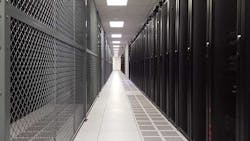After a Record 2022, Limits on Land and Power May Slow Data Center Growth in 2023
As the world continues its shift to digital services, demand for data center space has reached unprecedented levels. But after a record 2022, the data center sector may struggle to keep pace with demand in 2023 amid longer delivery timelines and shortages of power and land in key markets.
This trend was reinforced with new data this week from datacenterHawk, which included details on the record-smashing leasing in 2022 but last year, but cautioned that data center developers may struggle to keep pace with the huge appetite for cloud capacity.
"2022 was the biggest demand year we've ever seen in the data center space," said David Liggitt, CEO of datacenterHawk, which tracks data center leasing. "The pace at which development can occur is slowing down, which will impact the total growth in 2023.... Historically, the challenge has always been 'is there enough demand?' I think it's now flipped to whether there is enough supply to meet demand."
The new data aligns with the DCF 2023 forecast, where we noted that " data center space will be harder to find and could cost more, particularly in the second half of 2023."
Here's a look at what recent data tells us about the trends shaping the data center market.
Epic 2022 Leasing Sets Records
After a then-record 950 megawatts (MW) of absorption in North America in 2021, data center leasing surged to 2,250 megawatts in 2022, a 137% annual increase, according to datacenterHawk. The year got off to a bang with 800 MW of leasing in the first quarter, as hyperscale operators raced to procure cloud capacity for long-term growth amid concerns that delivery of future capacity may be slowed by supply chain disruptions. Some analysts theorized that the huge leasing represented "pull forwards," effectively shifting from future quarters.
But leasing remained solid through the rest of 2022, including 500 MW of leasing in the fourth quarter.
"Hyperscale requirements were larger than in prior years, often encompassing 70+ MW in a single lease," Liggitt wrote. "These transactions also occurred more frequently, from a larger group of companies, and in a wider selection of markets. Demand from enterprise users was also robust, particularly from financial, gaming, and tech companies."
The huge demand gobbled up much of the remaining space, resulting in the lowest vacancy rate ever, at 3.6%, with nearly 300 MW of combined available power across major North American markets. "A major portion of this capacity is stranded or in non-contiguous pieces under 5 MW," Liggitt noted.
A Challenging Landscape for Project Delivery
On the supply side, key markets are facing power constraints, and new deployment timelines may be slowed by supply chain issues and community resistance. In some key markets, the Internet is growing faster than the electrical infrastructure to support it.
At DCF we’ve written about power constraints creating supply bottlenecks in Northern Virginia and Silicon Valley. Other markets are seeing similar patterns emerge, according to JLL, including Dallas and Chicago. That power crunch has been noted by other market watchers as well.
"In 2023 we will continue to face supply chain issues related to availability of power," wrote Jim Kerrigan of North American Data Centers, another firm tracking wholesale data center activity. "In many markets developers will need to work much harder at securing land well in advance (3 years) of needing it and should pursue cover land plays while waiting for utilities to get the power to the site."
A covered land play is a strategy where a developer acquires an income-producing property with an existing business or building for future redevelopment. With open land dwindling in key markets like Northern Virginia and Silicon Valley, developers buy commercial properties and knock down the existing buildings to make way for purpose-built data centers.
"Land adjacent to high voltage electrical lines will command a premium price," Kerrigan wrote. "100-acre parcels or more with options to add additional land will be desired. Having room to adding a substation to the site with a way to get to a gigawatt will be the new focus to meet the demands of the hyperscale companies that are leasing 70 plus megawatts."
That type of lengthy development timeline suggests the data center supply pinch may not be a short-term phenomenon, like shortages in produce.
"A supply challenge does not solve itself quickly," Liggitt noted. "You can't just go make 100 transformers appear in a couple months. ... Since planning new developments now takes longer, many markets saw a decrease in planned power (future construction) in 4Q 2022."
A shortage of transformers for electrical distribution systems has been a factor in construction delays in housing and a number of industries, and is slowing infrastructure updates for utility grids.
Growth Shifts to Secondary Markets
As space and power grow scarce in major data center hubs, some requirements are shifting to secondary market, which have more land and power available to support new capacity. DCF first highlighted this trend in our 2022 forecast, which was borne out in new construction in emerging markets.
"There has been growing interest in secondary markets such as Portland, Phoenix, Columbus, Canadian markets among many others as operators seek larger sites with affordable power," noted Cushman and Wakefield in a recent report.
The disconnect between supply and demand is also defining new sub-markets as providers expand into "suburbs" of key Internet intersections. This trend has altered the geography in Northern Virginia. Data Center Alley in Ashburn remains hub for connectivity and data gravity. But the limited supply of land for data center development has led to new sub-markets in Arcola, Leesburg, Prince William County and now Frederick County, Maryland.
That trend is also being seen in Suburban Chicago, where data center development has shifted beyond the existing hubs in Elk Grove Village and Franklin Park, as seen in huge new projects in Itasca and Mount Prospect..
About the Author



